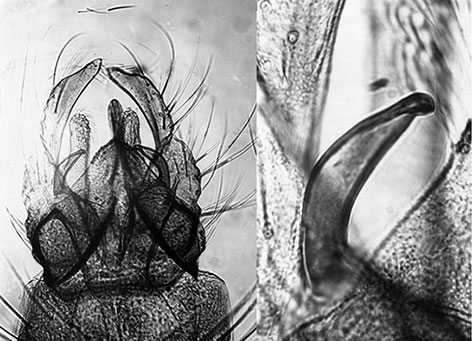Adults, pupae and larvae may be in the collection of J. E. Sublette, now in the museum of the University of Minnesota.
Male:

Male terminalia of C. "grodhausi".TIX with about 7 setae apparently in single spots. Anal point narrower at the base. Superior volsellar closest to S(f)-type of Strenzke (1959) and possibly darkened. Inferior volsella not reaching the end of the anal point but to about the midpoint of the moderately broad gonostylus which narrows markedly over the distal third to quarter; about 4+2 setae at tip.Female: Not described.
Pupa: Only the caudolateral spur of segment VIII has been recorded, with 1-3 spines at the end of the relatively broad base.
Fourth instar larva a medium sized plumosus-type. No length measurements recorded for tubuli.
Lateral tubules about 240 µm long; dorsal anal tubules shorter and thinner than the ventral pair (dorsal 270.5-426 µm long, 115-200 µm wide; ventral 270-506 µm long and 170-180 µm wide). Oesophageal opening 71-88 µm wide and 3.5-4.4 times wider than deep.
Gular region darkened over posterior half, wider than the mentum and widest at the posterior margin. FC probably darkened.
Gular region darkened over posterior half, frontoclypeus probably darkened.
Mentum (Fig. c) with pointed teeth; c1 tooth relatively broad with diverging sides, c2 teeth, although well seperated, virtually continue line of centre tooth (type 1B). Fourth laterals not reduced (type I-ii).
Ventromental plates (Fig. d) about 212-233 µm wide and 3.22-4.6 times wider than deep, 1.04-1.16 times wider than the mentum; separated by about 0.37 (0.35-0.39) of mentum width, with about 40.2 (37-45) striae, VMR about 0.22-0.4. Pecten epipharyngis (Fig. a) with about 12.6 (10-16) sharp but relatively broad teeth (type B).
Premandible (Fig. d) with outer tooth longer and coming to a fine point, inner tooth broad, about 4.1(3-6) times broader than outer.
Antenna (Fig. b) with basal segment about a third of the VHL and 2.8-3.9 times longer than wide, RO from a third to nearly halfway up from base of segment; AR abt 2.0-2.33; relative lengths of segments (micron) 126 : 32 : 8.2 : 12.5 : 7.7.
Mandible (Fig. e) with third inner tooth well developed but only partly darkened (Type IIIB), about 18.4 (14-22) furrows on outer surface near the base; 12-13 taeniae in PMa; Mdt-Mat 28.3 (20-35) µm; MTR 0.40-0.42. Possibly only two spines on the inner margin.
Cytology: 4 polytene chromosomes with the thummi arm combination AB, CD, EF, G.
Centromeres heterochromatic, showing tendency to stick together to form a centromere.
Large Balbiani ring (BR) near centre of closely paired arm G, with constriction between BR and centromere; another BR distal in the arm.
Nucleolus in arm B, just distal to the 4 characteristic bands; 1 or 2 nucleoli near the middle of arm D.
No polymorphism in small sample examined.
Arm A1: 1a-e, 2d-3, 12-10, 14 - 13, 4 - 9, 1f- 2c, 15-19
Arm B1: Nucleolus about 1/3 from centromere
Arm C1: possibly 1 - 6b, 11c - 8, 15 - 11d, 6gh, 17a - 16, 7d - 6c, 17b - 22 i.e. as sp. Apple Valley (sp. 3b)
Arm D1: 1 or 2 nucleoli near middle of arm
Arm E1: 1 - 3e, 5 - 10b, 4 - 3f, 10 - 13 i.e. as cingulatus, tardus and sp. 3b.
Arm F1: 1 - 23 i.e. Standard, as piger
Found: California - Lake Davis, Plumas Co. (abt 39.70°N, 120.50°W).
Some information on arm F given in Fig. 3 of Martin (1979). The cytology suggests a possible relationship to species Apple Valley (species 3b).
[ Return to Index| Go to C. atrella | Go to References ]